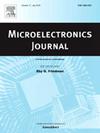Simulation study of inversion, accumulation, and junctionless mode monolayer MoS2/Ge heterojunction nanosheet at 1.5 nm node
IF 1.9
3区 工程技术
Q3 ENGINEERING, ELECTRICAL & ELECTRONIC
引用次数: 0
Abstract
This paper evaluates the performance of monolayer MoS2/Ge heterojunction n-channel nanosheet (MGHJFET) in various operating modes, including inversion mode (IM), accumulation mode (AC), and junctionless mode (JL), at the 1.5 nm technology node. To investigate these MGHJFET characteristics, a hybrid simulation approach was employed, combining atomistic simulations using density functional theory (DFT) with technology-computer-aided design (TCAD) simulations. The electrical characteristics of three types of MGHJFETs with different channel doping levels were analyzed. Further assessment was conducted on the analog and digital performance of the MGHJFETs in IM, AC, and JL modes. The IM and AC MGHJFETs exhibit superior performance due to current modulation in the monolayer MoS2. Specifically, the saturation current in IM and AC structures reaches up to A, and the / ratio achieves . By utilizing the 2D monolayer MoS2 material, the channel current of IM and AC MGHJFETs can be effectively modulated. Combined with the other advantages of 2D materials, this device is capable of scaling down to its smallest possible physical limits in the post-Moore era.
求助全文
约1分钟内获得全文
求助全文
来源期刊

Microelectronics Journal
工程技术-工程:电子与电气
CiteScore
4.00
自引率
27.30%
发文量
222
审稿时长
43 days
期刊介绍:
Published since 1969, the Microelectronics Journal is an international forum for the dissemination of research and applications of microelectronic systems, circuits, and emerging technologies. Papers published in the Microelectronics Journal have undergone peer review to ensure originality, relevance, and timeliness. The journal thus provides a worldwide, regular, and comprehensive update on microelectronic circuits and systems.
The Microelectronics Journal invites papers describing significant research and applications in all of the areas listed below. Comprehensive review/survey papers covering recent developments will also be considered. The Microelectronics Journal covers circuits and systems. This topic includes but is not limited to: Analog, digital, mixed, and RF circuits and related design methodologies; Logic, architectural, and system level synthesis; Testing, design for testability, built-in self-test; Area, power, and thermal analysis and design; Mixed-domain simulation and design; Embedded systems; Non-von Neumann computing and related technologies and circuits; Design and test of high complexity systems integration; SoC, NoC, SIP, and NIP design and test; 3-D integration design and analysis; Emerging device technologies and circuits, such as FinFETs, SETs, spintronics, SFQ, MTJ, etc.
Application aspects such as signal and image processing including circuits for cryptography, sensors, and actuators including sensor networks, reliability and quality issues, and economic models are also welcome.
 求助内容:
求助内容: 应助结果提醒方式:
应助结果提醒方式:


